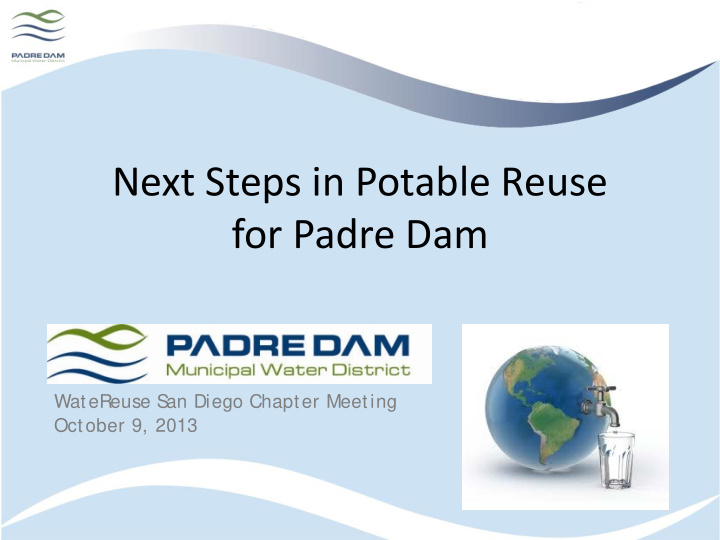



Next Steps in Potable Reuse for Padre Dam WateReuse S an Diego Chapter Meeting October 9, 2013
Presentation Outline • District Description • IPR Program • Santee Basin Status • Full Advanced Treatment Demonstration Project • Questions
Potable Water Wastewater Recycled Water Santee Lakes • 2 nd largest RV camp • 100% imported • 5 MGD generated • ~ 900 ac-ft/yr irrigation ground in SD County • ~12,000 ac-ft/year • 2 MGD Ray Stoyer (including 10 cabins) WRF • ~ 1,120 ac-ft/yr to • 34% reduction due to Santee Lakes • ~750,000 visitors/year conservation • Remaining to PLWWTP • Only permitted inland • Year round special live stream discharger events • Owns ~ 3% Metro treatment capacity
Padre Dam & IPR Adopted Strategic Goal to increase water, wastewater and energy independence – Add drought resistant local water supply – Continue to meet Title 22 obligations – Minimize future financial obligations associated with Pt. Loma waiver • Add capacity for IPR and GRRP
Santee GRRP Concept Minimum Retention Time or Response Time
Bureau of Reclamation Studies Completed To-date • Phase 1 – Feasibility Study completed in October 2011; – literature review and interpretation, – regulatory viability – engineering viability • Phase 2 – Electrical Resistivity Surveys, complete in December 2012
Phase 1 – Feasibility Study Results and Recommendations • Project has potential as a recharge project site • Capacity up to 3 mgd • Additional Study phases should occur to further refine data and analyses • Recommended that the next phase define the bedrock topography through geophysical methods.
Phase 2 - Resistivity Testing
Conductivity Survey
Resistivity Testing, Cont’ed
3-D Representation
Phase 2 – Electrical Resistivity Results • Depth to bedrock indicated by the ERI surveys is greater than assumed in the Phase 1 study • Capacity of the aquifer could be higher than what was estimated previously
Phase 2 – Electrical Resistivity Recommendations • Phase 3 – Targeted drilling to further calibrate the ERI results and determine hydraulic conductivities and transmissivities • Phase 4 – Development of a Groundwater Model and Management Plan • Phase 5 – Development of injection and extraction wells placements and operating strategies
IPR Program Timeline
PDMWD’s IPR Program Goals 1. Produce minimum of 15% of Districts Potable Supply (2,000 to 3,000 AF/Y of local supply) 2. Price of water < $2,000 /AF 3. Full Scale GRRP operation meeting regulatory requirements 4. Support District Strategic Goal 4 (Increase Water, Wastewater and Energy Independence 5. Limit Financial Obligations to the METRO wastewater system
Demonstration Project Contracts Envisioned to be accomplished under 2 separate contracts 1. Contract 1 – Program Management (Trussell Technologies, Inc.) 2. Contract 2 – Design and Installation of the Demonstration Facility
Shane Trussell, PhD. Trussell Technologies, Inc. FAT Demonstration Project
Padre Dam’s Full-Scale Vision
Ray Stoyer WRF
FAT Demo Treatment Train Free Chlorine MF High-recovery UV/AOP Disinfection RO 100,000 gpd 10 gpm
Principal FAT demo goals Issue Description Importance Extraction Injection Shortened • Higher IPR production Wells Wells response • Critical for reservoir 2 months retention time augmentation and 6 months DPR Free chlorine Free • Higher pathogen > 6 logs Chlorine credits at reduced Disinfection disinfection costs credit Chloramine 2 logs? Disinfection • Boosts capacity of existing infrastructure
Response Retention Time • Biggest issue is pathogen control • Redundant barriers best path to shorter RRTs Public Health Risk Barrier 1 Moderate Barrier 1 Barrier 2 Low Barrier 1 Barrier 2 Barrier 3 Negligible
Free-Chlorine Demonstration Chlorine Virus Control Hydraulics Inactivation System CT (6-log) Free-chlorine Demonstration Components
Nitrification Reliability
Schedule Task 2 2 2 IAP Task 1 Task 4 Task 5 Task 7 CDPH-Approved Procuremen Demonstratio Final Project Project Plan t Services n Testing Report CDPH Task 3 3 3 3 3 3 Approval CDPH Coordination Task 6 Brine 6 Mgmt. Sept 2013 Timeline June 2016
Padre Dam MWD Arne Sandvik, P.E. Project Manager Expert Advisors Independent Advisory Panel James Crook (chair) Amy Childress – USC Project Engineer Jason Dadakis – OCWD Dan Gerrity – UNLV Rick Gersberg – SDSU Channah Rock – U. of AZ Advanced Treatment CDPH / Regulatory Strategy
Questions and Discussion
Recommend
More recommend